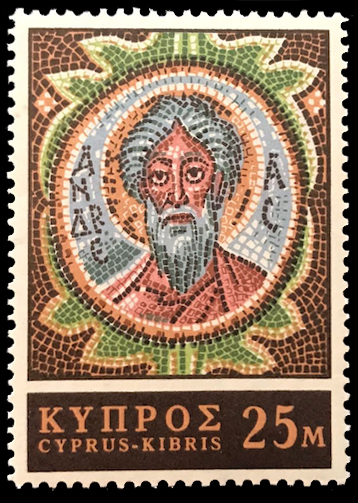The Stamp
T he stamp was issued from Cyprus on 8 November 1967 to celebrate the centenary of St Andrew’s Monastery.
he stamp was issued from Cyprus on 8 November 1967 to celebrate the centenary of St Andrew’s Monastery.
Although the oldest building in the monastery dates from the 15th century, the neoclassical church was built in 1867. The stamp, valued at 25 mills, was issued as a set of three with UNESCO (50M) and Exposition d'Art de Chypre, Paris 1967 (75M).
The Subject
St Andrew was a disciple of Jesus Christ. He was the brother of St Peter, and both were fishermen in Galilee. St Andrew was said to have been shipwrecked on the tip of the Karpass peninsular in Cyprus. As Andrew's staff hit the rocks, a miraculous spring appeared which healed the sea captain’s blind eye (no wonder they were wrecked!).
The site became a monastery and place of pilgrimage being called the ‘Lourdes of Cyprus’.
St Andrew was martyred by crucifixion on an "X" shaped cross, a saltire; he is the patron Saint of Scotland, and his cross is their flag.
Urology Connections
During the 6th century, Mummolus, an ambassador of Theudebert I (King of the Franks) was travelling to meet the emperor Justinian in Constantinople when he was struck down by bladder stones in Patras (the burial place of St Andrew). Believing he was dying, Mummolus wrote his will and called for help from any healer to ease his passage.
The local bishop suggested he would be better off praying to St Andrew than with a doctor. This he did, kneeling by Andrew's tomb throughout the night. At midnight, he suffered an attack of strangury, called for a pot and passed a large stone with a "clang".
A true miracle brought about by St Andrew!
← Back to Stamp Collection